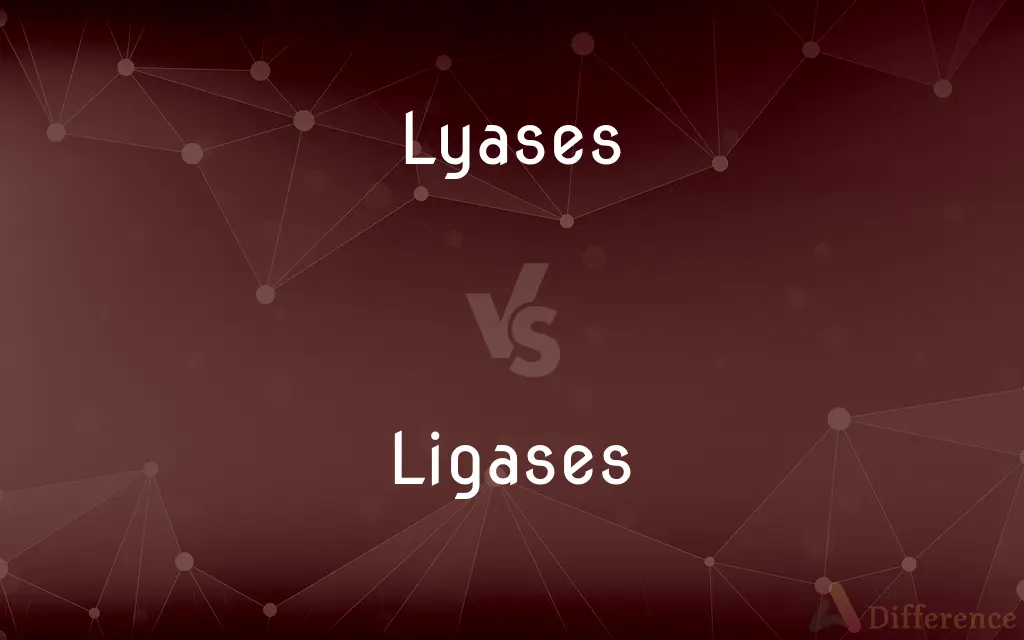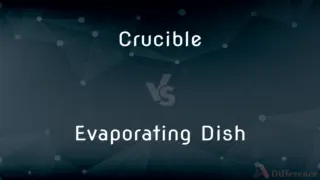Lyases vs. Ligases — What's the Difference?
Edited by Tayyaba Rehman — By Fiza Rafique — Published on February 23, 2024
Lyases catalyze the breaking of various chemical bonds by means other than hydrolysis and oxidation, helpful in glycolysis while ligases catalyze the joining of two molecules with the assistance of ATP, used in processes like DNA replication and repair.

Difference Between Lyases and Ligases
Table of Contents
ADVERTISEMENT
Key Differences
Lyases are enzymes that catalyze the cleavage of C-C, C-O, C-N, and other bonds in molecules through mechanisms that do not involve hydrolysis or oxidation. This action often results in the formation of double bonds or rings, making lyases integral in metabolic pathways, such as the conversion of citrate to isocitrate in the Krebs cycle. Ligases, on the other hand, function to connect two molecules together, using the energy derived from ATP hydrolysis. This makes them essential for synthesizing larger molecules from smaller precursors, such as the formation of phosphodiester bonds between nucleotides in DNA synthesis.
The action of lyases can be reversible, where they can also catalyze the addition of groups to double bonds, making them versatile in their function within biological systems. Ligases have a more specific role, often involved in critical cellular processes that require the precise assembly of complex molecules, including DNA replication and repair, where the accuracy of ligase activity is vital for maintaining genetic integrity.
Lyases are widespread in both catabolic and anabolic pathways, breaking down larger molecules into smaller ones or contributing to the biosynthesis of necessary compounds, such as the lyase that catalyzes the non-hydrolytic addition or removal of groups to form or break double bonds. Ligases are indispensable for cellular processes that require energy investment for bond formation, indicating their role in constructive metabolic pathways where energy coupling is necessary to drive reactions that are not spontaneously favorable.
In terms of application, lyases are used in various biotechnological and industrial processes, such as the production of antibiotics, where their ability to form or break chemical bonds finds practical utility. Ligases have found applications in genetic engineering and biotechnology, notably in the use of DNA ligase for recombinant DNA technology, where they are used to join DNA fragments, showcasing their importance in molecular biology research and biomedicine.
The understanding of lyase and ligase functions not only sheds light on their essential roles in metabolism and cellular repair mechanisms but also opens up avenues for therapeutic interventions. By targeting these enzymes, researchers can develop drugs that either inhibit or enhance their activity, offering potential treatments for diseases where their dysfunction plays a critical role.
ADVERTISEMENT
Comparison Chart
Catalytic Action
Cleavage of bonds without hydrolysis
Formation of bonds with ATP hydrolysis
Typical Reactions
Formation or breaking of double bonds
Joining of two molecules
Metabolic Role
Involved in both catabolic and anabolic pathways
Essential in biosynthesis and repair processes
Energy Requirement
Does not require external energy
Requires energy from ATP
Reversibility
Can be reversible
Typically unidirectional
Examples
Citrate lyase, isocitrate lyase
DNA ligase, aminoacyl-tRNA synthetase
Application
Production of antibiotics, biodegradation
DNA replication and repair, genetic engineering
Compare with Definitions
Lyases
Enzymes that catalyze bond breaking by elimination.
Isocitrate lyase splits isocitrate into succinate and glyoxylate in glyoxylate cycle.
Ligases
Essential for DNA synthesis and repair mechanisms.
Aminoacyl-tRNA synthetase attaches amino acids to tRNA in protein synthesis.
Lyases
Often involved in the formation of double bonds.
Fumarase catalyzes the hydration of fumarate to malate in the Krebs cycle.
Ligases
Applied in genetic engineering and biotechnology.
T4 DNA ligase is widely used in cloning to join DNA fragments in plasmids.
Lyases
Play roles in both breaking down and synthesizing compounds.
Aldolase breaks down fructose 1,6-bisphosphate in glycolysis.
Ligases
Involves energy investment from ATP.
Ligase reactions are crucial for forming long-chain fatty acids from acyl-CoA and malonyl-CoA.
Lyases
Does not require ATP to function.
Phenylalanine ammonia-lyase converts phenylalanine to cinnamate in plants.
Ligases
Enzymes that join two molecules with ATP hydrolysis.
DNA ligase seals nicks in the DNA backbone during replication and repair.
Lyases
Used in industrial processes for synthesis.
Carbonic anhydrase, a lyase, is used in carbon capture technologies.
Ligases
Typically work in a unidirectional manner.
E. coli DNA ligase is specific for joining Okazaki fragments on the lagging strand.
Lyases
Plural of lyase
Ligases
Plural of ligase
Lyases
Any of a class of enzymes that catalyze the cleavage of bonds without hydrolysis or oxidation, often resulting in a new double bond or ring structure, or that catalyze the addition of chemical groups to double bonds.
Ligases
Any of a class of enzymes that catalyze the linkage of two large molecules.
Common Curiosities
What makes ligases essential for DNA replication?
Ligases are crucial for connecting Okazaki fragments on the lagging strand during DNA replication, ensuring the continuity and integrity of the newly synthesized DNA strand.
Can ligases work without ATP?
No, ligases require ATP or a similar energy source to catalyze the bonding of molecules, as these reactions often involve energy input to be driven forward.
What role do ligases play in genetic engineering?
Ligases, especially DNA ligase, are pivotal in genetic engineering for splicing genes and inserting DNA fragments into vectors, enabling the creation of recombinant DNA molecules.
How do lyases differ from hydrolases?
Lyases catalyze bond breaking without water (non-hydrolytic), while hydrolases catalyze reactions that involve the breaking of bonds with the addition of water.
Are all lyases reversible in their action?
Not all, but many lyase reactions can be reversible, depending on the cellular conditions and the specific reaction dynamics.
How are lyases used in industrial applications?
Lyases are employed in the synthesis of various chemicals, including pharmaceuticals and biofuels, due to their ability to efficiently catalyze the formation or breaking of chemical bonds.
Are lyases and ligases found in all living organisms?
Yes, both lyases and ligases are ubiquitous in living organisms, reflecting their fundamental roles in metabolism, repair, and biosynthesis across different forms of life.
How is ATP involved in ligase activity?
ATP provides the energy needed for ligases to catalyze the formation of new bonds between molecules, often by first activating one of the substrates, making the reaction energetically favorable.
What distinguishes ligases in DNA repair from those in replication?
While their fundamental action is similar, ligases in DNA repair may have specificities for different types of DNA breaks or structures, ensuring precise repair of DNA damages beyond replication errors.
Can ligase activity be inhibited for therapeutic purposes?
Yes, inhibitors of specific ligases, such as DNA ligase inhibitors, are being explored as potential therapeutic agents, particularly in cancer treatment, where they could prevent DNA repair in cancer cells.
Share Your Discovery

Previous Comparison
Asian Lady Beetle vs. Ladybug
Next Comparison
Crucible vs. Evaporating DishAuthor Spotlight
Written by
Fiza RafiqueFiza Rafique is a skilled content writer at AskDifference.com, where she meticulously refines and enhances written pieces. Drawing from her vast editorial expertise, Fiza ensures clarity, accuracy, and precision in every article. Passionate about language, she continually seeks to elevate the quality of content for readers worldwide.
Edited by
Tayyaba RehmanTayyaba Rehman is a distinguished writer, currently serving as a primary contributor to askdifference.com. As a researcher in semantics and etymology, Tayyaba's passion for the complexity of languages and their distinctions has found a perfect home on the platform. Tayyaba delves into the intricacies of language, distinguishing between commonly confused words and phrases, thereby providing clarity for readers worldwide.
















































